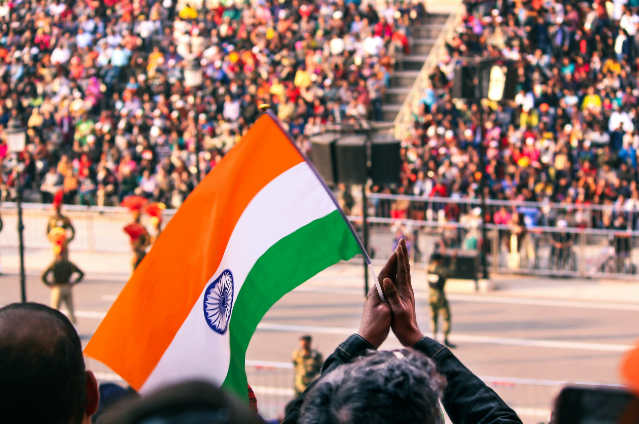
Photo by Prakhar Sharma on Unsplash
When Gandhi raised the call of 'Do or Die' in 1942, it wasn't a mere call of desperation, but rather a continuation; from rock carvings to bricks, beads, and bones, from megaliths to rock edicts and pillars, from stupas to stone temples, and from the janapadas to uttaramerur and finally the republic; of a path of struggle. Struggle involves efforts to achieve some goal. This goal is described as 'Dhamma' in Pillar Edict Two of Ashoka. In other words, a path of action. Rooted in the four golden concepts of Dhamma, Artha, Karma, and Moksha, each aspect seeks balance in thought and deed. This balance is beautifully described in the Taittreeya Upanishad as, 'Satyam Vada, Dharmam Chara.'
Essence of Continuity: Memory
Herbert Hope Risley, a former British colonial civil servant, argues that there is an underlying uniformity of life which exists from the Himalayas to Cape Comorin, reflected in the intellectual ferment in sixth century B.C. to the national consciousness in nineteenth century C.E. Events that shook the balance of power and ushered in a new dawn for we the people. But, where do we the people find the way? It comes from our philosophical endeavors.
And, what is philosophy if not the product of memory? Memory is said to be the root of all cultures. After all, Henry Vivian Derozio wrote: ‘I will keep thee like a thought, Which memory in her temple keeps.’ And Cultures have been using it as a tool to either encourage or warn future generations. For example, while the Mesolithic site of Sarai Nahar Rai provides evidence of conflict, where a microlithic arrowhead was found inside the ribs of a skeleton; in Mahadaha we find a story of love, where a couple was buried together.
The Upanishads, product of civilization, warn against learning without the discipline of conduct, in the form of righteous earning, legitimate desire, and upholding values. Values such as tolerance, compassion, and altruism. Interestingly scientists argue that the act of helping and cooperating with others is the factor that aided in the rise of homo sapiens.
Ashoka emphasizes this point when talking about intolerance in his major rock edict XII, which reads: 'Whoever praises his own sect and blames other sects with a view to glorify his own sect, rather injures his own.'
This message was translated into action by Sankar Deva, in the sixteenth century C.E. to open the door of salvation and brotherhood through faith and prayers rather than complex rituals and sacrifices. It paved the way for unity. Unity inspired low caste Moamoria sects to rise against the tyranny and oppression in the sixteenth century C.E. Ahom Kingdom.
In Mahabharata, Lord Krishna tells a demotivated Arjun, ‘Happy is the warrior to whom the joy of battle comes.’ When Gandhi raised the mantra of 'Do or Die',' people faced the tyrants with only determination, the strength of character and the support of their brethren. For the first time in history, the transfer of power happened on friendly terms, and resulted in our Independence Day. A day to remember our roots.
Roots, Identity and the Youth
Our roots define our identity, and identity is never unitary in nature. For example, while Mahabali is considered a demon in some parts of the country, Malayalis celebrate his arrival as Onam. The reason is simple: cultural and geographical context.
Nadeem Hasnain highlights this point in his book 'Indian Society, Themes, and Social issues.' His argument is that India is a plural society trying to be multicultural. And, being multicultural implies respecting other cultures and values. To use an analogy, just because a river passes through a big lake doesn't necessarily mean the lack becomes the river. Similarly, various cultures co-existing is the true essence of a nation's distinct identity. This fact was acknowledged by our founding fathers in the form of the fifth and the sixth schedule.
Even before that Sankarcharya, in the first century C.E., established four maths in the four corners of the land to give the people a sense of belonging. This sense had a massive impact in the form of the socio-religious reforms of the nineteenth century when a new generation of youth decided to take a stand against social evils such as Sati, Infanticide, and Child marriage etc.
Priyam Goswami, in her book, The History Of Assam, From Yandabo to Partition, 1826-1947, raises an interesting point. Notably, the reformers looked to the wisdom of the Shastras, a tool of encouragement, to argue that Shastras never discouraged women's education. After all, Gargi, Apala, and Maitreyi are shining examples of women's contributions to society. Lack of Education meant no progress for the nation. Another consequence was a communication gap between husband and wife; women couldn't fulfill their role as the intellectual companion of men. In effect, the loss of national productivity and identity.
Of course, not everyone agreed. But the debate provided visibility to women's issues and brought change in society's attitude. An attitude that women could lead. Leaders like Chandraprava Saikiani, and Nalinibala Devi embodied the spirit of Swaraj; Mongri, a tea garden laborer, was the first woman in Assam to lay her life at the altar of freedom; proving themselves to be better fighter and equal to men even without any weapons. Without them, the Quit India Movement wouldn't be successful. Today, as India is led by a second female president, the contributions of these remarkable women who stood against the tide, remind the nation of the wisdom of Indian thinkers.
The Aitreya Brahmana beautifully sums up the essence of the path of Dhamma: 'Charaivati, Charaivati.' The traveller on this path is guided by passion, pride, and profound insight of those who came before. When the Chandrayan 3 landed on the moon in 2023, in a way, we the people truly celebrated our long journey.
